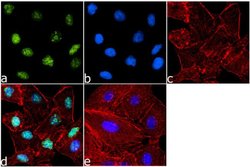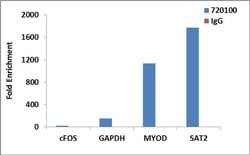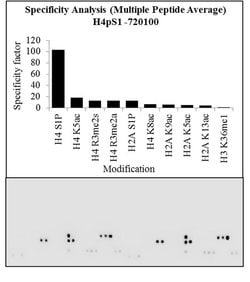Learn More
Invitrogen™ Phospho-Histone H4 (Ser1) Polyclonal Antibody
Rabbit Polyclonal Antibody
Supplier: Invitrogen™ 720100
Description
These Polyclonal antibodies are of rabbit origin developed by immunizing animals with proteins or peptides. The polyclonal antibody is purified by affinity purification from the rabbit sera generated after immunizing the rabbits with a specific type of protein or peptide. The purified antibody is tested for its functionality in various relevant research applications. The antibody is developed for Research Use Only and is non-hazardous or non-infectious in nature. Since it is highly conserved across species, the antibody may react with many other species.
Histones are basic nuclear proteins that are responsible for the nucleosome structure of the chromosomal fiber in eukaryotes. Two molecules of each of the four core histones (H2A, H2B, H3, and H4) form an octamer, around which approximately 146 bp of DNA is wrapped in repeating units, called nucleosomes. The linker histone, H1, interacts with linker DNA between nucleosomes and functions in the compaction of chromatin into higher order structures. This gene is intronless and encodes a member of the histone H4 family. Transcripts from this gene lack polyA tails but instead contain a palindromic termination element. This gene is found in the large histone gene cluster on chromosome 6.
Specifications
| Phospho-Histone H4 (Ser1) | |
| Polyclonal | |
| Unconjugated | |
| H4C1 | |
| BcDNA:RH52884; BUR5; CELE_T10C6.11; CG31611; CG3379; CG3379-PA; CG3379-PB; CG3379-PC; CG3379-PD; CG33869; CG33871; CG33873; CG33875; CG33877; CG33879; CG33881; CG33883; CG33885; CG33887; CG33889; CG33891; CG33893; CG33895; CG33897; CG33899; CG33901; CG33903; CG33905; CG33907; CG33909; Dmel\CG3379; Dmel_CG3379; F07B7.11; F07B7.4; F45F2.12; FBtr0082962; FO108; germinal histone H4; H1ft; H4; H4 clustered histone 11; H4 clustered histone 2; H4 histone family, member A; H4 histone family, member I; H4 histone family, member J; H4 histone family, member M; H4 histone family, member N; H4 histone, family 2; H4.1; H4/A; H4/B; H4/C; H4/D; H4/E; H4/G; H4/H; H4/I; H4/J; H4/K; H4/M; H4/N; H4/O; H4/p; H4-12; H4-16; H4-53; H4c1; H4C11; H4c12; H4C13; H4c14; H4C15; H4C2; H4c3; H4C4; H4C5; H4c6; H4c8; H4C9; H4f16; H4F2; H4FA; H4FB; H4FC; H4FD; H4FE; H4FG; H4FH; H4FI; H4FJ; H4FK; H4FM; H4FN; H4FO; H4ft; H4M; H4r; HHF1; HHF2; HHT1; HHT2; his-20; his-22; His4; his-4; His4:CG31611; His4:CG33869; His4:CG33871; His4:CG33873; His4:CG33875; His4:CG33877; His4:CG33879; His4:CG33881; His4:CG33883; His4:CG33885; His4:CG33887; His4:CG33889; His4:CG33891; His4:CG33893; His4:CG33895; His4:CG33897; His4:CG33899; His4:CG33901; His4:CG33903; His4:CG33905; His4:CG33907; His4:CG33909; His4-88CD; His4r; His4r-PA; His4r-PB; His4r-PC; His4r-PD; his-52; his-54; his-8; HIST1H46L2; HIST1H4A; hist1h4a.L; Hist1h4b; HIST1H4C; HIST1H4D; HIST1H4E; Hist1h4f; Hist1h4h; Hist1h4i; Hist1h4j; HIST1H4K; HIST1H4L; Hist1h4m; HIST2H4; Hist2h4a; HIST2H4B; Hist4; Hist4h4; histone 1, H4a; histone 1, H4b; histone 1, H4e; histone 1, H4i; histone 1, H4l; histone 2, H4; histone 2, H4a; Histone 4; Histone 4 family, member M; histone 4, H4; histone cluster 1, H4a; histone cluster 1, H4a L homeolog; histone cluster 1, H4b; histone cluster 1, H4e; histone cluster 1, H4i; histone cluster 1, H4-IV, germinal H4-like 2; histone cluster 1, H4-IV, germinal H4-like 2 (similar to human histone cluster 1, class H4 genes); histone cluster 2, H4; histone cluster 2, H4a; Histone Cluster 4; histone cluster 4, H4; histone family member; Histone H2B 2; Histone H3; histone H4; histone H4 replacement; histone H4.1; Histone H4A; histone IV, family 2; K06C4.12; K06C4.4; N2749; N2752; OGP; Osteogenic growth peptide; RH52884p; SIN2; T10C6.11; X04652; XELAEV_18001418mg; YBR009C; YBR010W; YBR0122; YBR0201; YNL030W; YNL031C | |
| Rabbit | |
| Affinity chromatography | |
| RUO | |
| 121504, 8294, 8359, 8363, 8366, 8367, 8370 | |
| Store at 4°C short term. For long term storage, store at -20°C, avoiding freeze/thaw cycles. | |
| Liquid |
| Peptide Array, ChIP Assay, Western Blot, Immunocytochemistry | |
| 0.5 mg/mL | |
| PBS with 0.1% BSA, 30% glycerol and 0.09% sodium azide; pH 7.2 | |
| P62805 | |
| H4-16, H4C1, H4C11, H4C14, H4C2, H4C5, H4C9, HIST1H4A | |
| Phosphopeptide corresponding to Human HIST1H4A (aa 1-7). | |
| 100 μg | |
| Primary | |
| Human | |
| Antibody | |
| IgG |
Your input is important to us. Please complete this form to provide feedback related to the content on this product.



